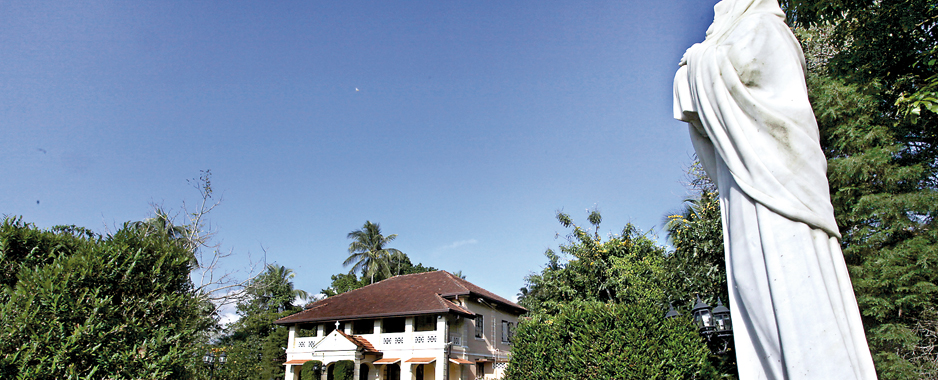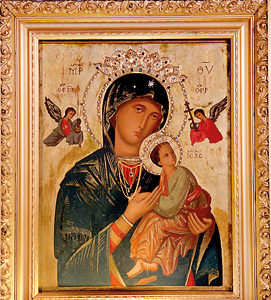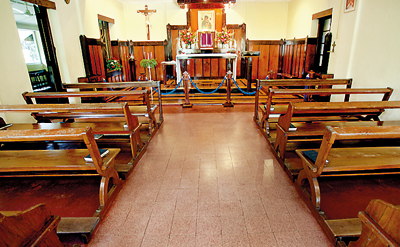Sancta Maria: Miracle shrine atop a hill
View(s):By Kumudini Hettiarachchi
Holding her child closely in her arms, she looks down serenely, benevolently and tenderly at the world. This is the mother, who with Joseph by her side, would be overjoyed at the birth of her baby but would also have her heart crushed by anguish to see her beloved son’s agony on the cross.

A mission school now a lovely shrine. Pix by M.A. Pushpa Kumara
As Christians across the globe celebrate the birth of Jesus Christ, there would be no Holy Babe without the mother.
Up on a hill, at the end of winding George E. de Silva Mawatha, away from the hustle and bustle of Kandy town, is a beautiful little shrine, set amidst tranquillity, dedicated to her – Sancta Maria or Holy Mary.
Tales abound of miracles linked to this first shrine of Our Mother of Perpetual Help in Sri Lanka.
“It was back in 1939 that three Redemptorist priests came from Ireland to start a branch of the Congregation of the Most Holy Redeemer in then Ceylon and carried with them the picture of Our Mother of Perpetual Help,” says the Superior of the Redemptorist House, Fr. Shanti Abeyasingha, who in his manner of speaking and actions exudes the true Christian spirit.
The three pioneers, taking after their founder St. Alphonsus Maria Liguori of Italy who had set up a society of missionary priests in 1732, were Fr. Matthew Hickey, Fr. Liam O’Halloran and Fr. Jerry McDonald who strove to “imitate the virtues and examples of Jesus Christ, our Redeemer, consecrating themselves especially to the preaching of the word of God to the poor”.
 Fr. Shanti Abeysingha |
 Anton Joseph: Faithful caretaker |
And the icon they brought with them of the Mother of Perpetual Help, derived from the Latin Sancta Maria de Perpetuo Succurso had a history of its own. Of Oriental origin, the first icon, it is believed, had been stolen by a merchant from Crete around the 16th century and taken to Rome, after being storm-tossed for awhile.
With both the merchant and his friend dying before they could return the icon to a church, it had gone to its rightful place only after Mother Mary had appeared to the merchant’s six-year-old daughter requesting her to persuade her mother to give it back.
Finding a home and veneration for 300 years in the Church of St. Matthew, sandwiched between the major basilicas of St. Mary Major and St. John Lateran in Rome, the “extraordinary events” associated with this icon had been many.
In 1798, however, the French Army commanded by Napoleon had destroyed the church, but the Redemptorists had built a new church on the same site, finding among the rubble, the unmarred icon. It had been then that Pope Pius XI put the Redemptorist priests in charge of the image, assigning guardianship with the direction: “Make her known throughout the world.”

Our Mother of Perpetual Help
When the Redemptorists put down permanent roots in Kandy on March 15, 1946, they dedicated their shrine to ‘Sancta Maria’ while the lovely wooden altar which draws hundreds of devotees even now had been built by Fr. Arthur Maloney with his own hands and looked after down the years by all those who have had the privilege of serving here.
Calling the faithful caretaker Anton Joseph who had come as a lad and remained here for nearly three decades, keeping the shrine spic and span and tending to the finely manicured garden, Fr. Abeyasingha showers praise on him.
With large numbers flocking from all corners of the country to seek her powerful intercession with God through the Novena to Our Mother of Perpetual Help begun at Sancta Maria, the first novena outside this shrine had been started in 1951 by Fr. Christie McCarthy at All Saints Church in Borella.
Up at the Sancta Maria shrine, the picture of ‘Our Mother’ had been crowned in 1957.
Explaining the symbolisation of this picture which adorns almost all Catholic homes, Fr. Abeyasingha says the star on her veil reminds us that she is the Morning Star and the Star of the Sea guiding us to the safe haven of Jesus Christ; the Greek initial is for St. Michael the Archangel depicted holding the lance and the gall-sop of the Passion of Jesus; the red tunic the colour worn by virgins during the time of Christ and the dark blue mantle the colour worn by mothers in Palestine because Mary is both virgin and mother; the clasped hands of Jesus and Mary a human gesture of protection and trust; the golden crown a sign of her queenship; and the Greek initial for St. Gabriel the Archangel as he holds the cross and the nails.

A labour of love: The lovely wooden altar built by Fr. Arthur Maloney with his own hands
“Mary’s eyes look at us with love, tenderness and mercy while the other Greek initials are for Christ. Mary’s left hand supporting the Christ child possessively is a comforting hand for anyone who calls on her and the falling sandal signifies the fear of the child on foreseeing what is to come (agony and death on the cross). In his hurry to clasp his mother’s hand, his sandal has come loose,” adds Fr. Abeyasingha.
Of a quiet and still afternoon, we look up at Our Lady of Perpetual Help in the glow of the red lamp at the Sancta Maria shrine. Her crown shines in the dimness and something else catches our eyes – two gold chains are around her neck, with a garnet pendant dangling from one.
Miraculous powers are attributed to the icon, says Fr. Abeyasingha with humility, offering the booklet ‘A bouquet of thanks’ where the “miracles” including ‘Curing of a spine ailment’, ‘Obtaining a surgical position’, ‘Cure from cancer’, ‘Restoring of eye sight’, ‘Safety from a nasty accident’ from Germany, ‘The road led to her’, ‘Entrance to Law College’, ‘Protection from false accusation’ are part of a long list.
Picking just one from among the numerous, Fr. Abeyasingha refers to an incident in February 1958. A woman expecting her first baby had been admitted to the Frazer Memorial Ward of the Kandy Hospital due to complications.
The doctor had been of the opinion that both mother and baby may lose their lives. In desperation, the husband had removed the gold chain and pendant from around his unconscious wife’s neck, hurried to the Sancta Maria shrine and laid it on the altar, weeping for succour.
By the time he returned to the hospital, dreading the worst, the baby had been born and both mother and child had been fine.
Fifty-four years later, that gold chain and garnet pendant still hang around the neck of Our Lady as testimony not only to favours received but also the faith generated by this shrine. This is the secret which draws men, women and children from all communities and religions to Sancta Maria to light a candle and whisper a fervent wish or prayer.
Follow @timesonlinelk
comments powered by Disqus


















